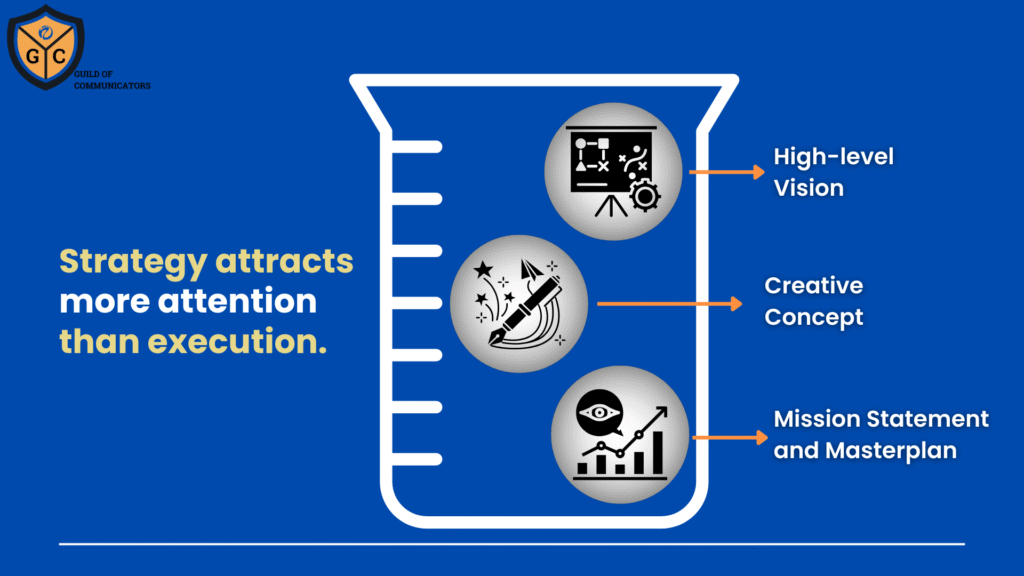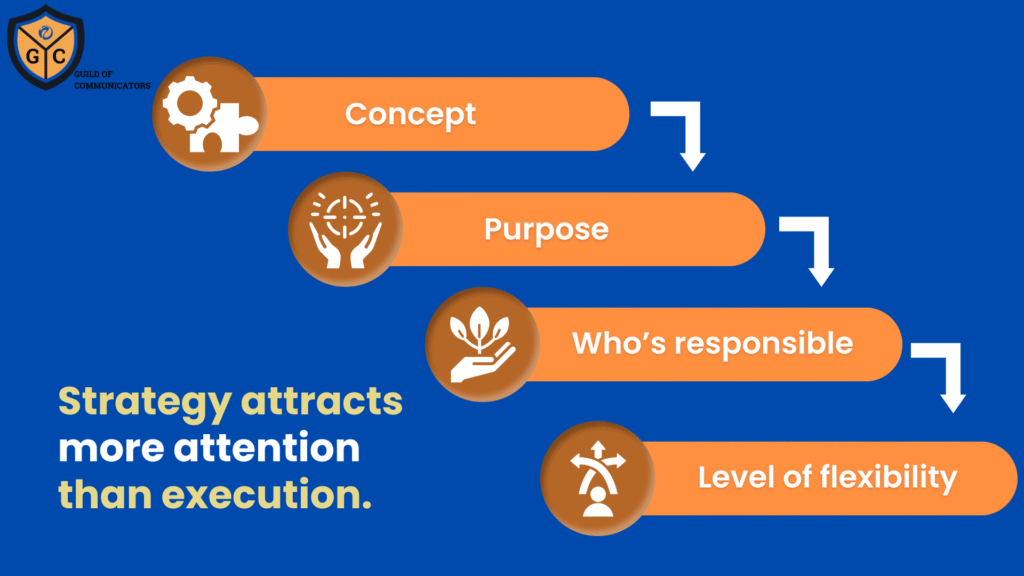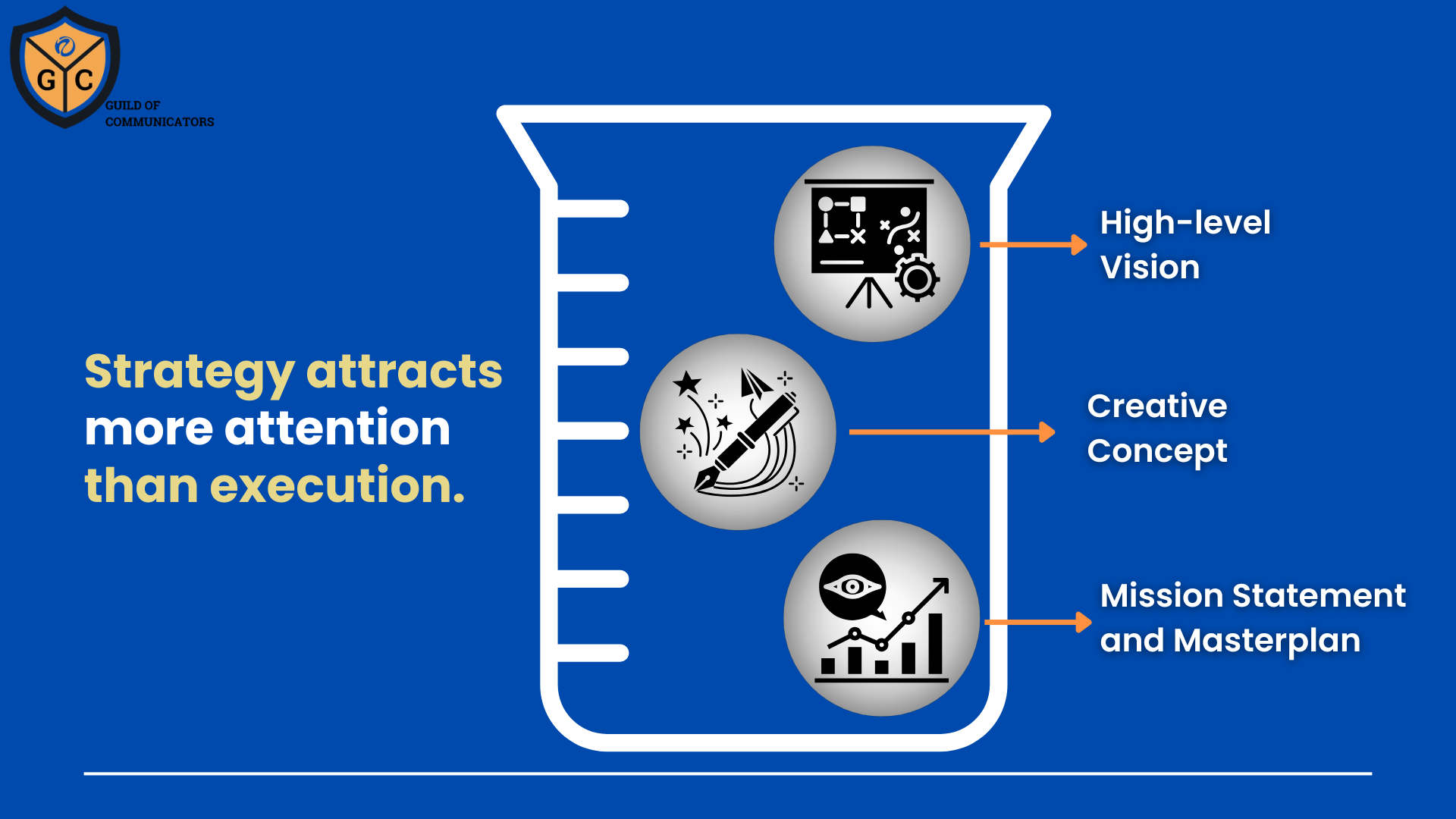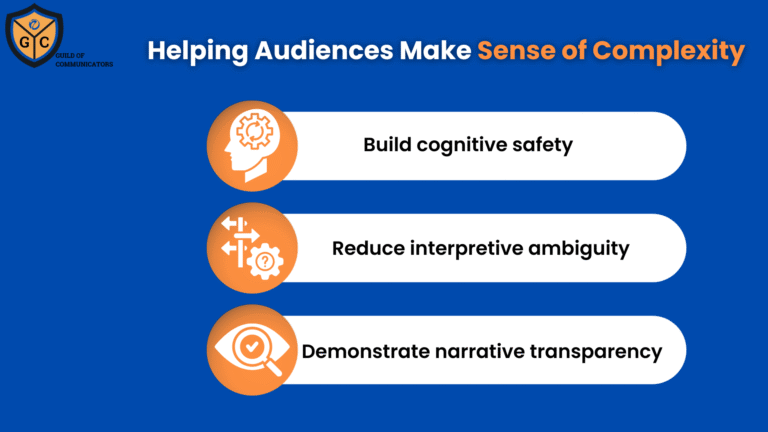A common challenge faced by communicators is learning how to separate strategy from operations when planning and running programmes or campaigns. The terms are often used interchangeably, but they serve different purposes. Without a clear distinction, plans can quickly become muddled, that is, they are too broad to be actionable or too granular to remain focused.
Understanding the difference between the ‘why’ and the ‘how’ of a communication programme helps communicators design work that is both purposeful and executable. It also makes it easier to align with stakeholders, allocate resources, and deliver results.
Strategy Alone Does Not Deliver Results
Strategy tends to attract more attention than execution. It often feels more prestigious or intellectually stimulating, and it’s where many communicators are eager to contribute. But there’s a tendency to treat strategy as a container for everything—a high-level vision, a creative concept, a mission statement, and a masterplan rolled into one.
This broad approach can obscure clarity. When strategy tries to encompass every element of a campaign, it becomes hard to draw the line between what must remain constant and what can adapt. Campaign plans start to feel rigid, with every action and message tied too closely to a single overarching idea.
In reality, strategy serves best when it sets direction and defines success. It should articulate what matters most, not dictate every step that follows.

Avoiding the Trap of Strategy-Led Constraints
When strategy is treated as fixed, it creates pressure to align all outputs with the original concept—regardless of how the situation evolves. This can result in campaign tactics that are out of sync with audience needs, or measurement frameworks that reward activity rather than progress.
Inflexible plans often ignore changing realities on the ground. For example, stakeholder priorities might shift, public sentiment may change, or timelines may tighten. If the operational elements of a campaign—such as key messages, channel choices, or timing—are tightly bound to the initial strategy, teams may struggle to adapt quickly.
Allowing for some movement at the operational level, while still staying aligned to strategic intent, helps teams stay relevant and effective in dynamic environments.
Where Strategy Ends and Execution Begins
One of the most useful skills communicators can develop is the ability to distinguish between strategic intent and operational decisions.
Strategy answers the questions: Why are we doing this? What change are we trying to bring about? Operations, on the other hand, are about how we’ll do it, who will be involved, and when it will happen.
By treating the two as distinct but connected, campaign teams can hold fast to the central idea while adjusting the execution to suit the context. For example, a strategy might prioritise building stakeholder trust. Operationally, this could translate into different tactics depending on the platform, audience segment, or timing.
Keeping the strategic idea intact, but allowing for flexibility in how it is realised, enables better decision-making and more responsive implementation.
Think in Modules, Plan with Precision
A helpful mindset for communicators is to view campaigns as modular systems.
Each module—strategy, objectives, messaging, channels, measurement—has its own function and scope. By compartmentalising these components, it becomes easier to assess each one on its own terms and adjust as needed without disrupting the entire programme.
This modular view also makes planning and collaboration more manageable. Team members can take ownership of specific areas while still aligning with the broader plan. It also makes review and evaluation more structured, as outcomes can be tied clearly to distinct operational objectives rather than abstract goals.
Ultimately, compartmentalisation allows communicators to balance the need for coherence with the need for adaptability.

Structuring Campaigns for Clarity and Action
A well-constructed campaign plan clearly separates strategic elements from operational details. It outlines the overarching goal, defines specific objectives, and explains the approach.
The plan smoothly moves into the operational phase—who will do what, when, and how success will be tracked.
Separating strategy from operations doesn’t mean working in silos—it means respecting the function of each element. When communicators learn to define, structure, and plan across both dimensions, campaigns become easier to manage, adapt, and scale.
This structure not only brings clarity to the team but also supports better stakeholder engagement. Decision-makers can focus on strategic alignment, while delivery teams concentrate on execution. The separation of concerns makes it easier to troubleshoot, adapt, and report.
By learning to see the difference between idea and action – and planning accordingly -communicators can avoid confusion, respond to change, and achieve stronger outcomes.
*****
Join the Guild of Communicators at www.gocommunicators.com.
The Guild of Communicators (Go Communicators) stands as the preferred community for communicators seeking to elevate their craft. Through our Academy of Excellence, we provide best-in-class frameworks, fit-for-purpose resources, and opportunities that support members in achieving professional excellence.
We provide the following resources, tools and opportunities to members:
- Best-in-Class Resources: We provide our members with access to frameworks, playbooks and tools that empower them to achieve and maintain professional excellence.
- Continuous Learning and Growth: Through our comprehensive training programmes, workshops, delivered digitally, 24/7 and in-person, we support the ongoing professional development of communicators.
- A Supportive Network: GOC fosters a vibrant community where communicators can connect, collaborate, and support each other, creating a network that champions mutual growth and success.
- Shared Knowledge and Expertise: Our members benefit from the collective wisdom and experience of a diverse group of communication professionals, enhancing their skills and perspectives.
Go Communicators is dedicated to amplifying the impact and value that communicators bring to their organisations, highlighting their crucial role in driving success and growth.
We equip our members with the strategies and tools needed to become influential leaders and business partners within their organisations, enhancing their ability to drive positive change and outcomes.
Through our support and resources, communicators can demonstrate clear, measurable outcomes that showcase their value and impact, reinforcing their importance to their organisations.
Join the Guild of Communicators at www.gocommunicators.com
Subscribe to join over 1500+ communicators and brands getting value every Tuesday while reading A Communicator’s Perspective, our weekly newsletter.



